Evaluating Grid Size Suitability of Population Distribution Data via Improved ALV Method: A Case Study in Anhui Province, China
Abstract
:1. Introduction
2. Materials and Methods
2.1. Study Area
2.2. Gridded Population Distribution Data
2.3. Methods
2.3.1. ALV Method Application Principles
2.3.2. Proposed ALV Method
3. Results
3.1. Results Based on Traditional ALV Method
3.2. Results Based on Proposed ALV Method
4. Discussion
4.1. Comparative Analysis
4.2. Grid Size Suitability Analysis
4.3. Grid Size Suitability Verification
5. Conclusions
Acknowledgments
Author Contributions
Conflicts of Interest
References
- Du, G.; Zhang, S.; Zhang, Y. Analyzing spatial auto-correlation of population distribution: A case of Shenyang city. Geogr. Res. 2007, 26, 383–390. [Google Scholar]
- Bai, Z.; Wang, J.; Yang, F. Research progress in spatialization of population data. Prog. Geogr. 2013, 32, 1692–1702. [Google Scholar]
- Patel, N.N.; Stevens, F.R.; Huang, Z.; Gaughan, A.E.; Elyazar, I.; Tatem, A.J. Improving large area population mapping using geotweet densities. Trans. GIS 2017, 21, 317–331. [Google Scholar] [CrossRef] [PubMed]
- Li, Y.; Yang, X.; Wang, J. Grid size suitability of population spatial distribution in shandong province based on landscape ecology. Geogr. Geo-Inf. Sci. 2014, 30, 97–100. [Google Scholar]
- Mennis, J. Generating surface models of population using dasymetric mapping. Prof. Geogr. 2003, 55, 31–42. [Google Scholar]
- Du, G.; Zhang, S.; Zhang, Y. Analyzing scale effects of population density with shenyang city as a case. J. Grad. Sch. Chin. Acad. Sci. 2007, 24, 186–192. [Google Scholar]
- Ming, D.; Wang, Q.; Yang, J. Spatial scale of remote sensing image and selection of optimal spatial resolution. J. Remote Sens. 2008, 12, 529–537. [Google Scholar]
- Ye, J.; Yang, X.; Jiang, D. The grid scale effect analysis on town leveled population statistical data spatialization. J. Geo-Inf. Sci. 2010, 12, 40–47. [Google Scholar] [CrossRef]
- Wang, P.; Shi, P.; Wei, W.; Zhang, S. Grid scale effect and spatialization of population density based on the characteristic of spatial autocorrelation in Shiyang River Basin. Adv. Earth Sci. 2012, 27, 1363–1372. [Google Scholar]
- Woodcock, C.E.; Strahler, A.H. The factor of scale in remote sensing. Remote Sens. Environ. 1987, 21, 311–332. [Google Scholar] [CrossRef]
- Bocher, P.K.; McCloy, K.R. The fundamentals of average local variance—Part I: Detecting regular patterns. IEEE Trans. Image Process. 2006, 15, 300–310. [Google Scholar] [CrossRef] [PubMed]
- Ming, D.; Li, J.; Wang, J.; Zhang, M. Scale parameter selection by spatial statistics for geobia: Using mean-shift based multi-scale segmentation as an example. ISPRS J. Photogramm. Remote Sens. 2015, 106, 28–41. [Google Scholar] [CrossRef]
- Atkinson, P.M.; Curran, P.J. Choosing an appropriate spatial resolution for remote sensing investigations. Photogramm. Eng. Remote Sens. 1997, 63, 1345–1351. [Google Scholar]
- Curran, P.J. The semivariogram in remote sensing: An introduction. Remote Sens. Environ. 1988, 24, 493–507. [Google Scholar] [CrossRef]
- Woodcock, C.E.; Strahler, A.H.; Jupp, D.L.B. The use of variograms in remote sensing: I. Scene models and simulated images. Remote Sens. Environ. 1988, 25, 349–379. [Google Scholar] [CrossRef]
- Qin, C.; Hu, X. Review on scale-related researches in grid-based digital terrain analysis. Geogr. Res. 2014, 32, 270–283. [Google Scholar]
- Hu, X.; Qin, C. Effects of different topographic attributes on determining appropriate dem resolution. Prog. Geogr. 2014, 33, 50–56. [Google Scholar]
- Zheng, H. Study the Fundamentals of Detecting Spatial Pattern in Remote Sensing Images by Comparing Average Local Variance with Semi-Variograms. Ph.D. Thesis, Northeast Institute of Geography and Agroecology, University of Chinese Academy of Sciences, Jilin, China, 2014. [Google Scholar]
- Mccloy, K.R.; Bøcher, P.K. Optimizing image resolution to maximize the accuracy of hard classification. Photogramm. Eng. Remote Sens. 2007, 73, 893–903. [Google Scholar] [CrossRef]
- Wang, Y.Q.; Liu, W.; Wang, Y. Image quality acessment based on local variance and structure similarity. J. Optoelectron. Laser 2008, 19, 1546–1553. [Google Scholar]
- Bocher, P.K.; McCloy, K.R. The fundamentals of average local variance—Part II: Sampling simple regular patterns with optical imagery. IEEE Trans. Image Process. 2006, 15, 311–318. [Google Scholar] [CrossRef] [PubMed]
- Schmidt, J.; Andrew, R. Multi-scale landform characterization. Area 2005, 37, 341–350. [Google Scholar] [CrossRef]
- Yang, X.; Zhang, S.; Xia, Y. Coupling pattern evolution of “population-economy-space-environment” in the counties of anhui province. Geogr. Geo-Inf. Sci. 2017, 33, 81–126. [Google Scholar]
- Yang, X.; Huang, Y.; Dong, P.; Jiang, D.; Liu, H. An updating system for the gridded population database of china based on remote sensing, gis and spatial database technologies. Sensors (Basel) 2009, 9, 1128–1140. [Google Scholar] [CrossRef] [PubMed]
- Lloyd, C.D.; Atkinson, P.M. Scale and the spatial structure of landform: Optimising sampling strategies with geostatistics. In Proceedings of the 3rd International Conference on GeoComputation, Bristol, UK, 17–19 September 1998. [Google Scholar]
- Dong, N.; Yang, X.; Cai, H. Research progress and perspective on the spatialization of population data. J. Geo-Inf. Sci. 2016, 1295–1304. [Google Scholar] [CrossRef]
- Dong, N.; Yang, X.; Cai, H.; Xu, F. Research on grid size suitability of gridded population distribution in urban area: A case study in urban area of Xuanzhou district, China. PLoS ONE 2017, 12, e0170830. [Google Scholar] [CrossRef] [PubMed]
- Dragut, L.; Eisank, C. Object representations at multiple scales from digital elevation models. Geomorphology (Amst) 2011, 129, 183–189. [Google Scholar] [CrossRef] [PubMed]
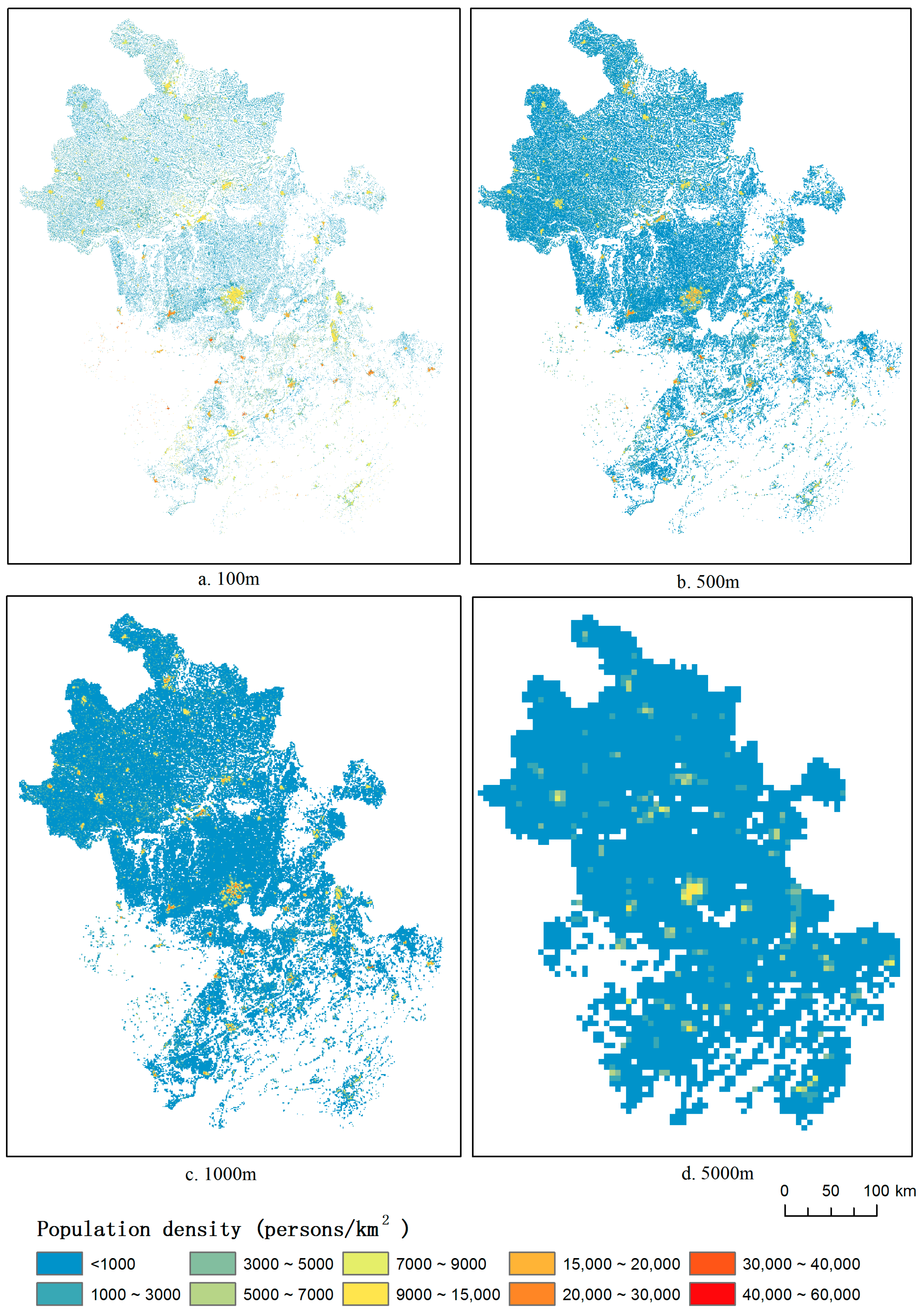

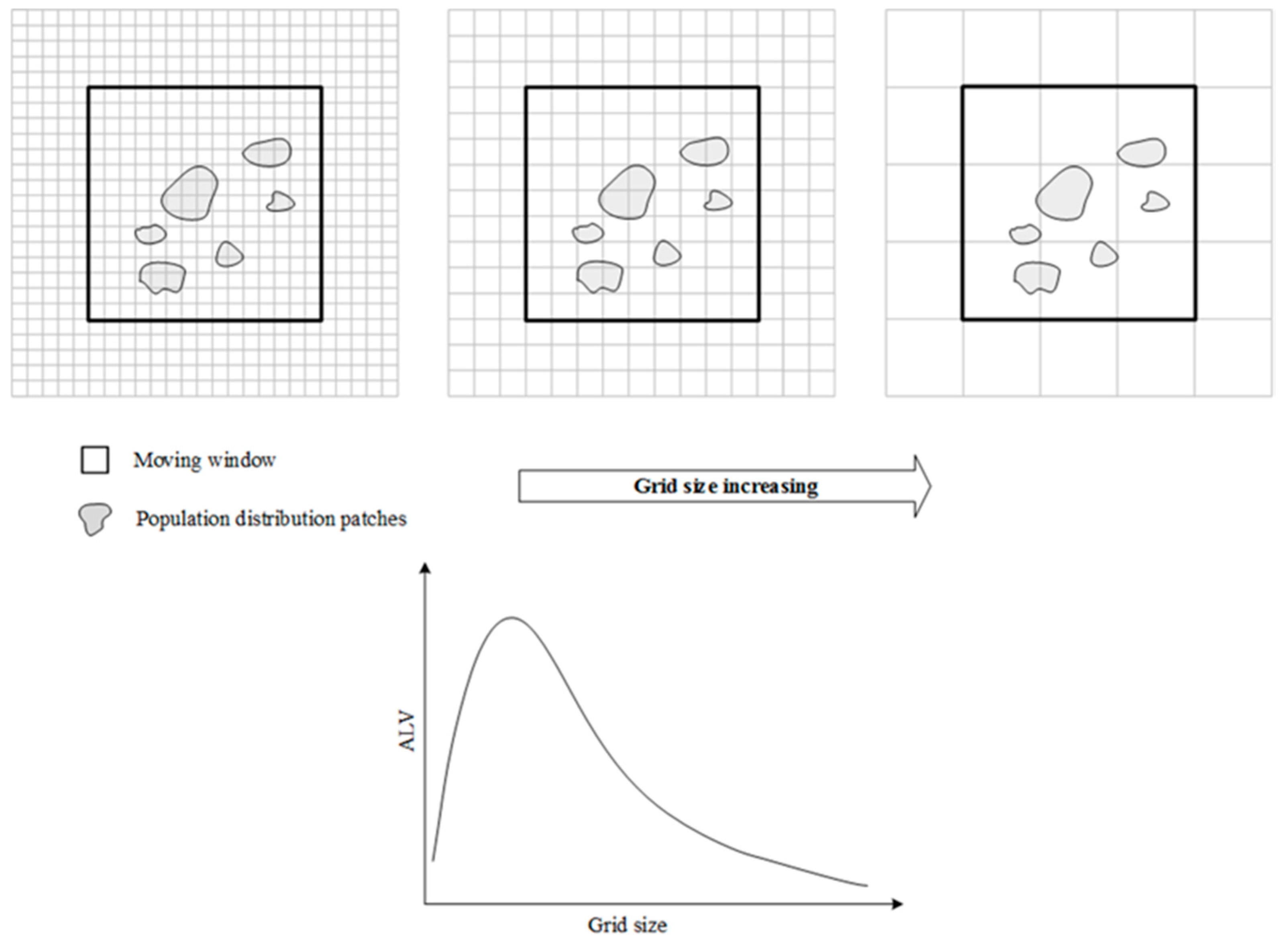
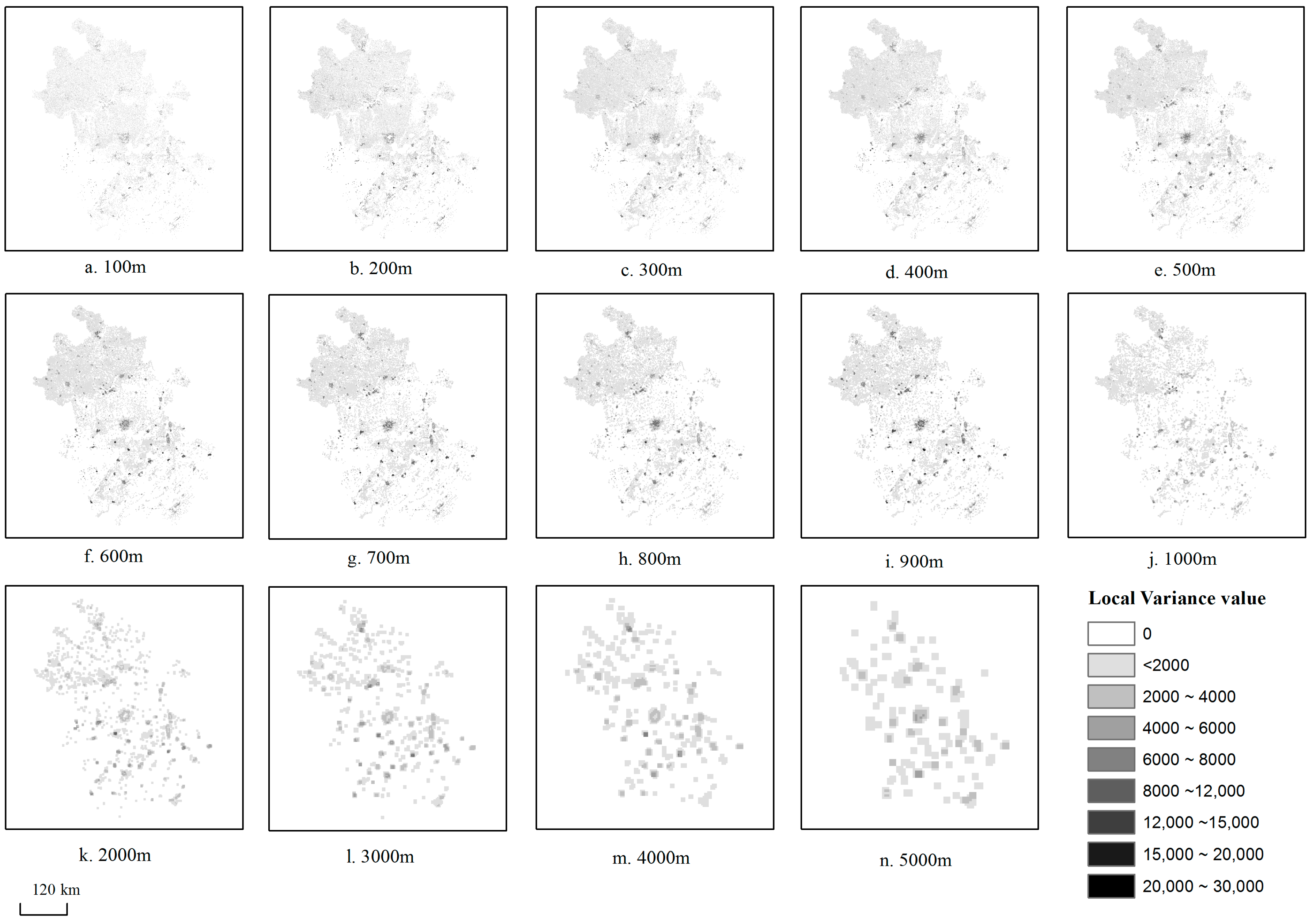
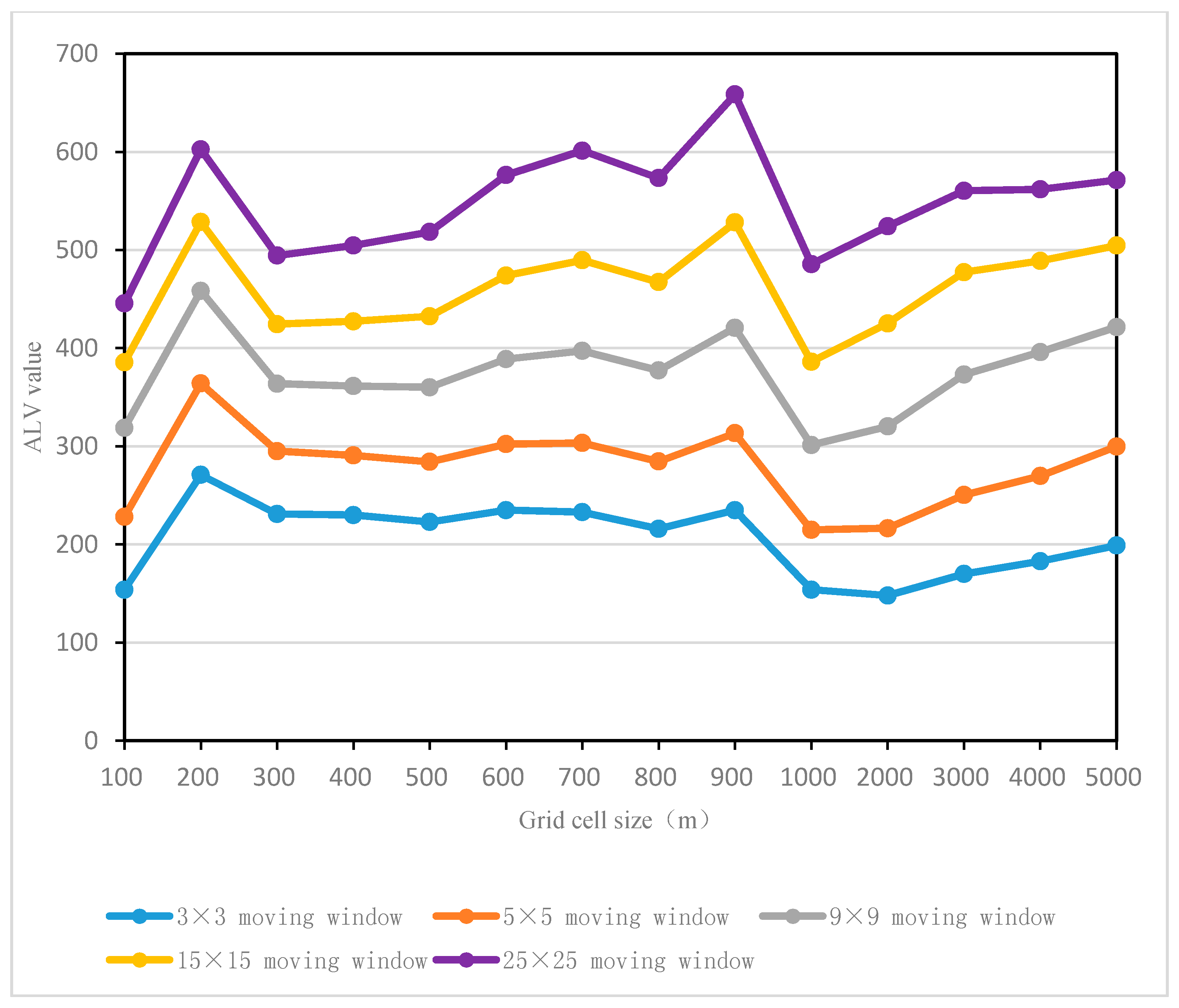
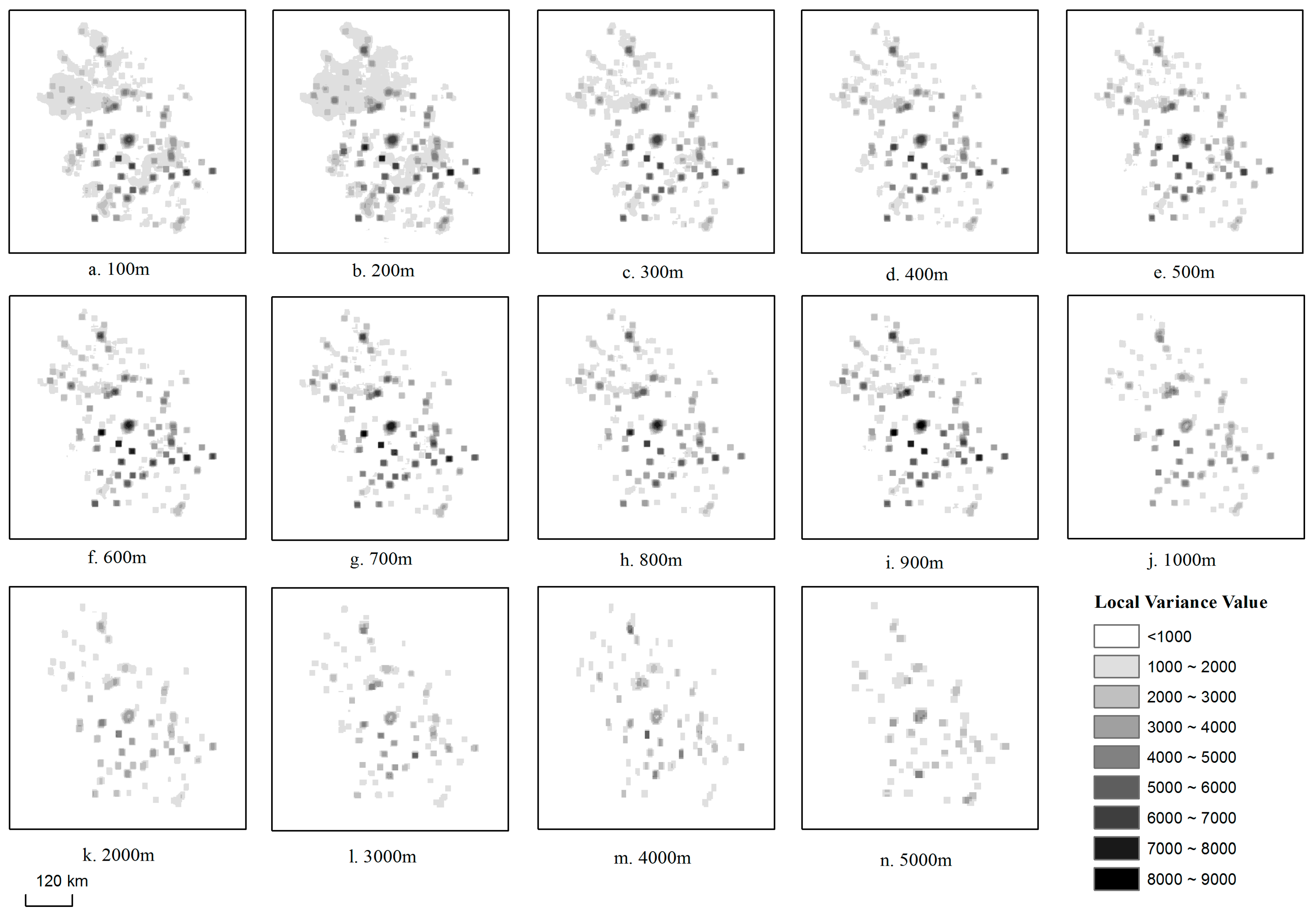
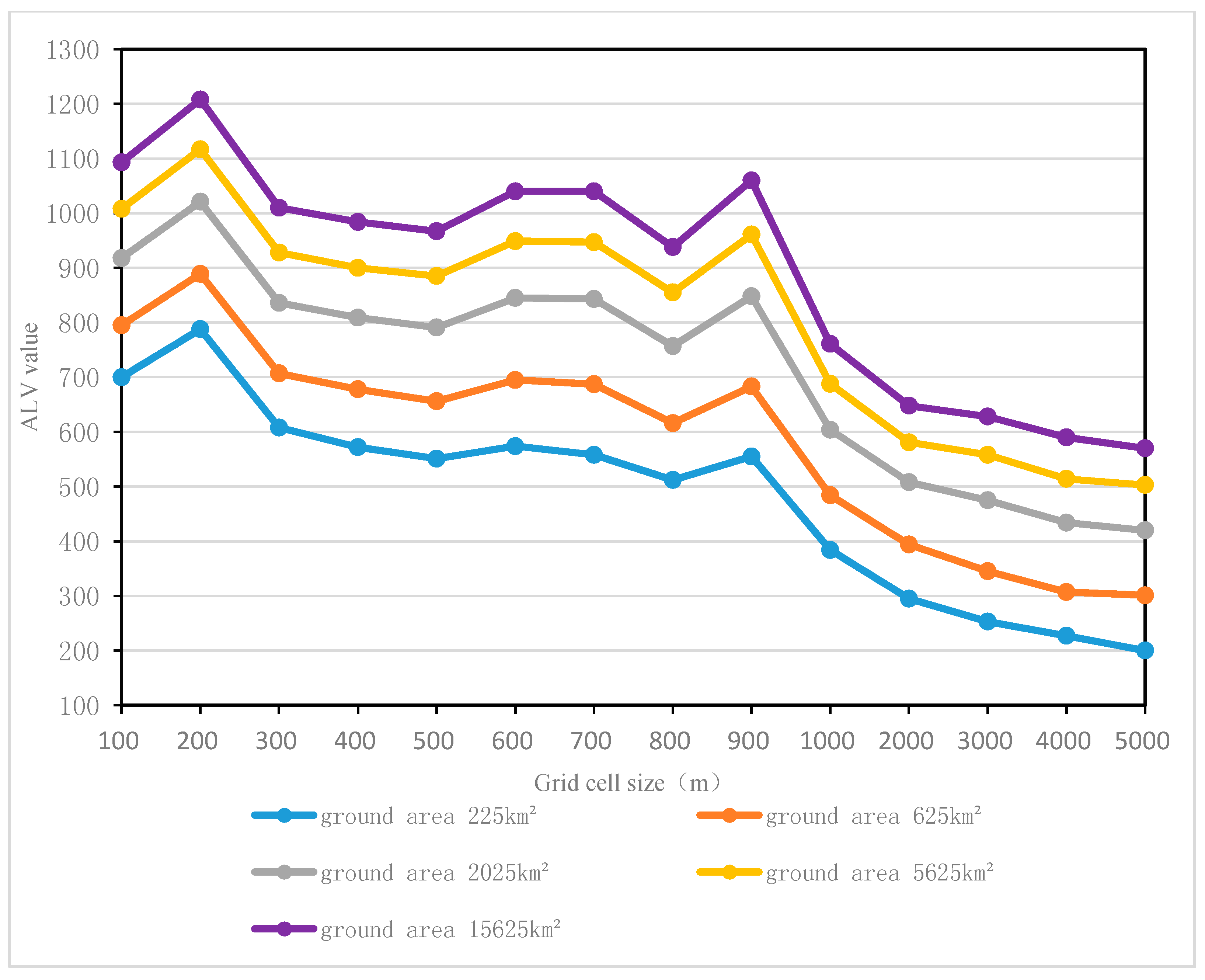
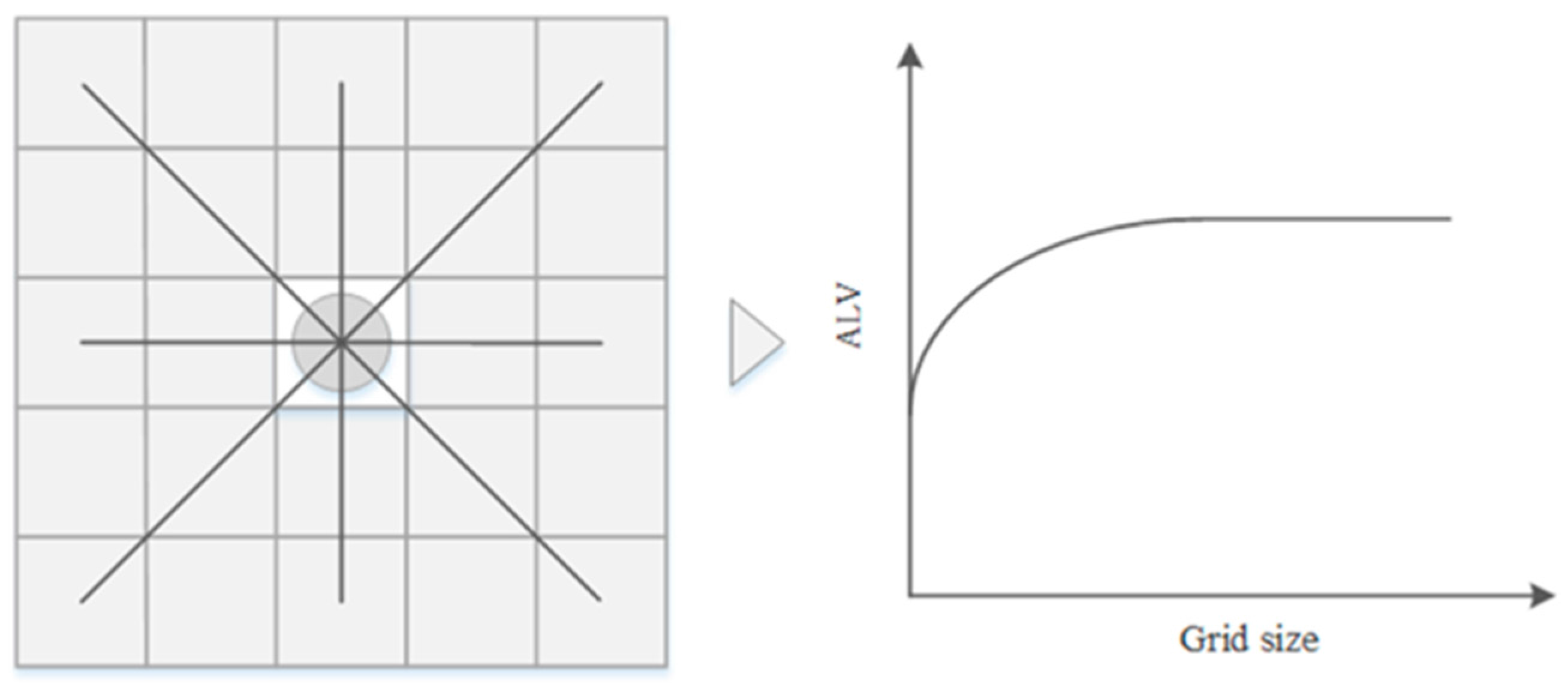
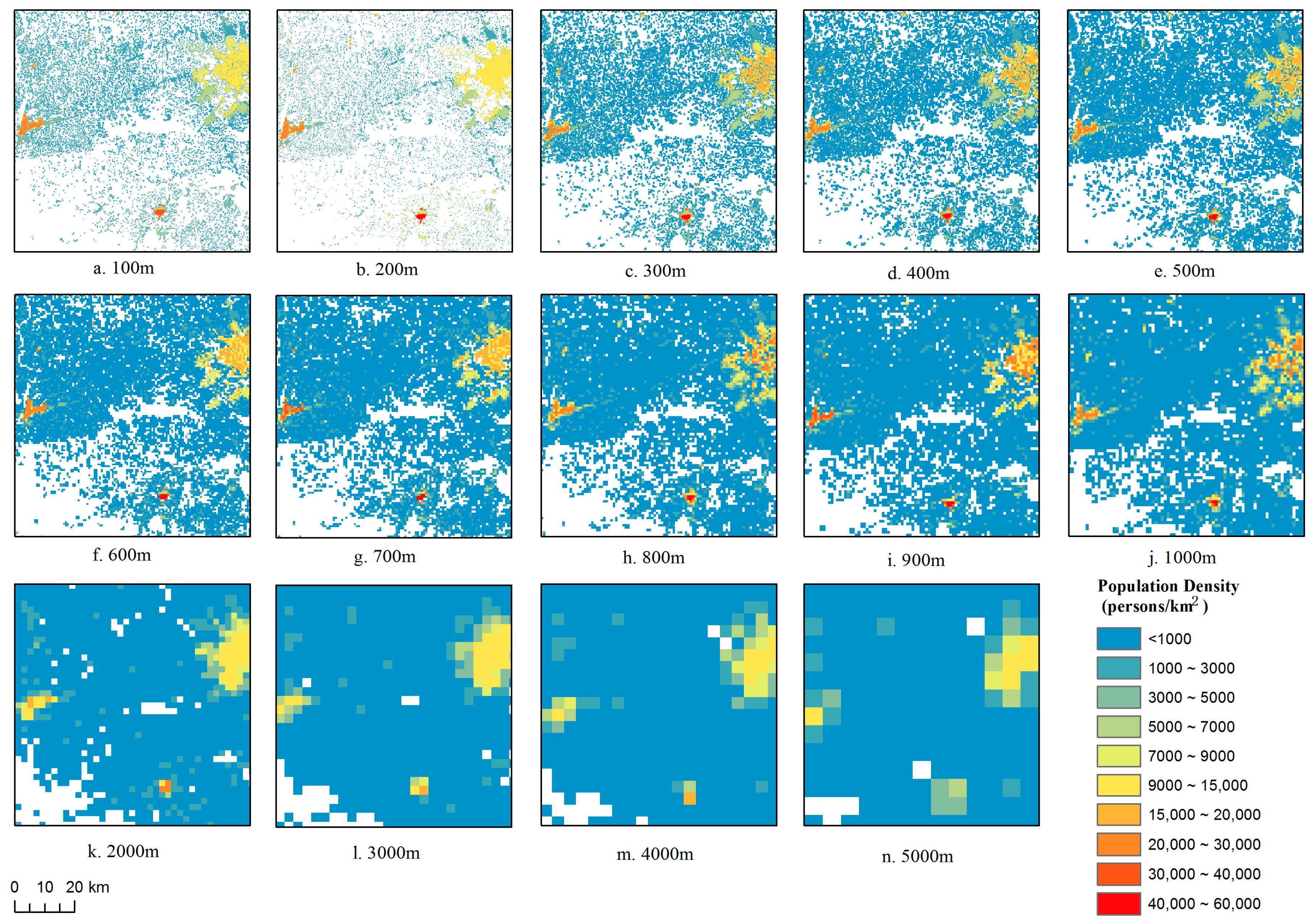
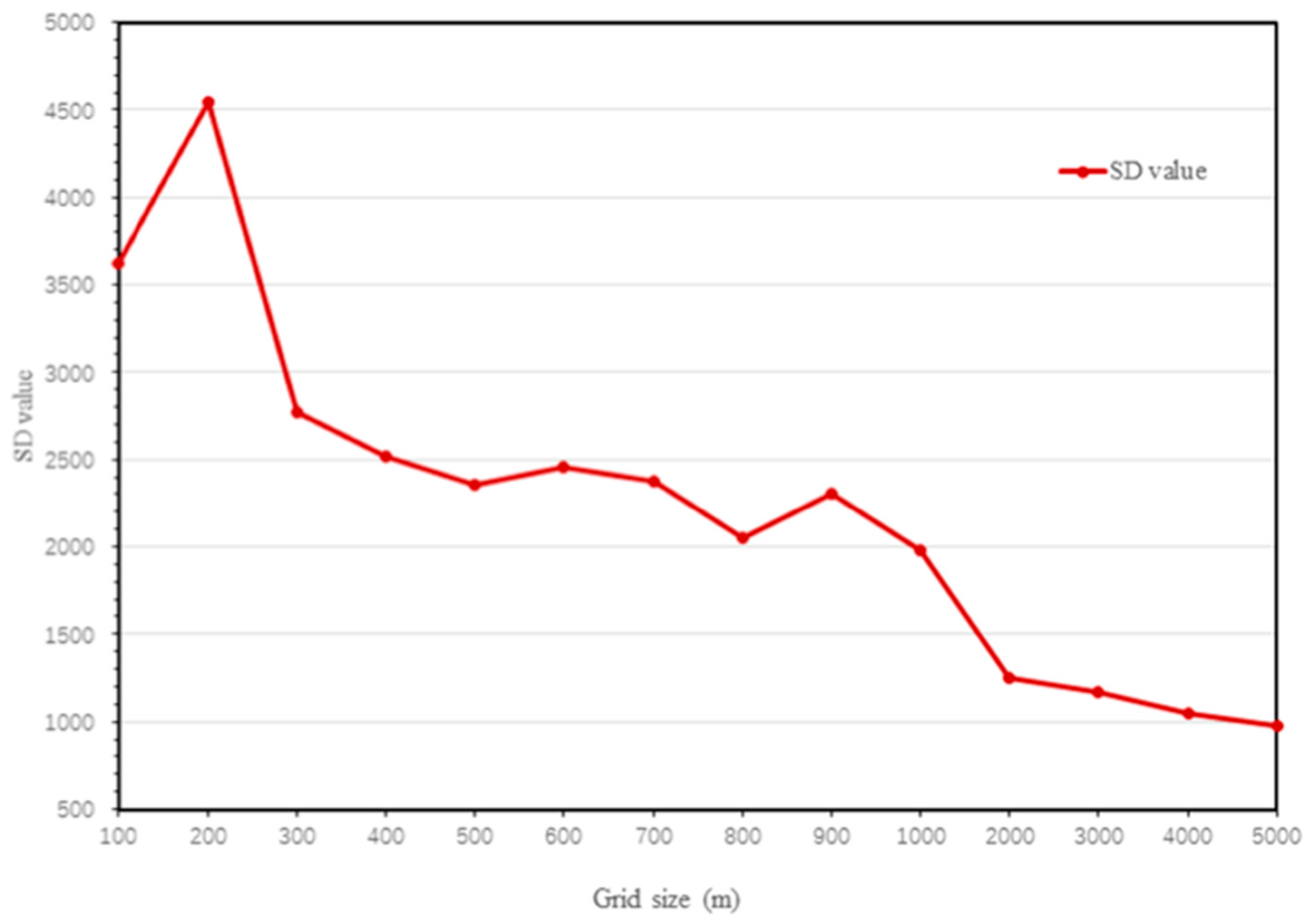
| Name | Time | Datatype | Scale/Resolution | Data Resources |
|---|---|---|---|---|
| Census data | 2010 | Excel | County level | State Bureau of Statistics of China |
| Boundary of counties | 2010 | vector | 1:1,000,000 | Resources and Environmental Scientific Data Center (RESDC), Chinese Academy of Sciences (CAS) |
| Boundary of townships | 2010 | vector | 1:1,000,000 | RESDC |
| Land use | 2010 | grid | 1 km × 1 km | RESDC |
| Grid Size (m) | Moving Window Size | Actual Ground Area (m2) |
|---|---|---|
| 100 | 3 × 3 | 90,000 |
| 200 | 3 × 3 | 360,000 |
| 300 | 3 × 3 | 810,000 |
| Theoretical Ground Area (km2) | Grid Size (m) | Theoretical Window Size | Actual Window Size | Actual Ground Area (km2) | Area Error (%) |
|---|---|---|---|---|---|
| 225 | 100 | 150 × 150 | 151 × 149 | 224.99 | 0.00 |
| 200 | 75 × 75 | 75 × 75 | 225 | 0.00 | |
| 300 | 50 × 50 | 51 × 49 | 224.91 | 0.04 | |
| 400 | 37.5 × 37.5 | 37 × 37 | 219.04 | 2.65 | |
| 500 | 30 × 30 | 31 × 29 | 224.75 | 0.11 | |
| 600 | 25 × 25 | 25 × 25 | 225 | 0.00 | |
| 700 | 21.43 × 21.43 | 21 × 21 | 216.09 | 3.96 | |
| 800 | 18.75 × 18.75 | 19 × 19 | 231.04 | 2.68 | |
| 900 | 16.66 × 16.66 | 17 × 17 | 234.09 | 4.04 | |
| 1000 | 15 × 15 | 15 × 15 | 225 | 0.00 | |
| 2000 | 7.5 × 7.5 | 9 × 7 | 252 | 12.00 | |
| 3000 | 5 × 5 | 5 × 5 | 225 | 0.00 | |
| 4000 | 3.75 × 3.75 | 5 × 3 | 240 | 6.67 | |
| 5000 | 3 × 3 | 3 × 3 | 225 | 0.00 | |
| 625 | 100 | 250 × 250 | 251 × 249 | 624.99 | 0.00 |
| 200 | 125 × 125 | 125 × 125 | 625 | 0.00 | |
| 300 | 83.33 × 83.33 | 83 × 83 | 620.01 | 0.80 | |
| 400 | 62.5 × 62.5 | 63 × 63 | 635.04 | 1.61 | |
| 500 | 50 × 50 | 51 × 49 | 624.75 | 0.04 | |
| 600 | 41.67 × 41.67 | 43 × 41 | 634.68 | 1.55 | |
| 700 | 35.71 × 35.71 | 37 × 35 | 634.55 | 1.53 | |
| 800 | 31.25 × 31.25 | 31 × 31 | 615.04 | 1.59 | |
| 900 | 27.78 × 27.78 | 29 × 27 | 634.23 | 1.48 | |
| 1000 | 25 × 25 | 25 × 25 | 625 | 0.00 | |
| 2000 | 12.5 × 12.5 | 13 × 13 | 676 | 8.16 | |
| 3000 | 8.33 × 8.33 | 9 × 7 | 567 | 9.28 | |
| 4000 | 6.25 × 6.25 | 7 × 5 | 560 | 10.40 | |
| 5000 | 5 × 5 | 5 × 5 | 625 | 0.00 | |
| 2025 | 100 | 450 × 450 | 451 × 449 | 2024.99 | 0.00 |
| 200 | 225 × 225 | 225 × 225 | 2025 | 0.00 | |
| 300 | 150 × 150 | 151 × 149 | 2014.91 | 0.50 | |
| 400 | 112.5 × 112.5 | 113 × 113 | 2043.04 | 0.89 | |
| 500 | 90 × 90 | 91 × 89 | 2024.75 | 0.01 | |
| 600 | 75 × 75 | 75 × 75 | 2025 | 0.00 | |
| 700 | 64.29 × 64.29 | 65 × 65 | 2070.25 | 2.23 | |
| 800 | 56.25 × 56.25 | 57 × 55 | 2006.4 | 0.92 | |
| 900 | 50 × 50 | 51 × 49 | 2024.19 | 0.04 | |
| 1000 | 45 × 45 | 45 × 45 | 2025 | 0.00 | |
| 2000 | 22.5 × 22.5 | 23 × 23 | 2116 | 4.49 | |
| 3000 | 15 × 15 | 15 × 15 | 2025 | 0.00 | |
| 4000 | 11.25 × 11.25 | 11 × 11 | 1936 | 4.40 | |
| 5000 | 9 × 9 | 9 × 9 | 2025 | 0.00 | |
| 5625 | 100 | 750 × 750 | 751 × 749 | 5624.99 | 0.00 |
| 200 | 375 × 375 | 375 × 375 | 5625 | 0.00 | |
| 300 | 250 × 250 | 251 × 249 | 5624.91 | 0.00 | |
| 400 | 187.5 × 187.5 | 187 × 187 | 5595.04 | 0.53 | |
| 500 | 150 × 150 | 151 × 149 | 5624.75 | 0.00 | |
| 600 | 125 × 125 | 125 × 125 | 5625 | 0.00 | |
| 700 | 107.14 × 107.14 | 107 × 107 | 5610.01 | 0.27 | |
| 800 | 93.75 × 93.75 | 95 × 93 | 5654.4 | 0.52 | |
| 900 | 83.33 × 83.33 | 83 × 83 | 5580.09 | 0.80 | |
| 1000 | 75 × 75 | 75 × 75 | 5625 | 0.00 | |
| 2000 | 37.5 × 37.5 | 37 × 37 | 5476 | 2.65 | |
| 3000 | 25 × 25 | 25 × 25 | 5625 | 0.00 | |
| 4000 | 18.75 × 18.75 | 19 × 17 | 5168 | 8.12 | |
| 5000 | 15 × 15 | 15 × 15 | 5625 | 0.00 | |
| 15,625 | 100 | 1250 × 1250 | 1251 × 1249 | 15,624.99 | 0.00 |
| 200 | 625 × 625 | 625 × 625 | 15,625 | 0.00 | |
| 300 | 416.66 × 416.66 | 417 × 417 | 15,650.01 | 0.16 | |
| 400 | 312.5 × 312.5 | 313 × 313 | 15,675.04 | 0.32 | |
| 500 | 250 × 250 | 251 × 249 | 15,624.75 | 0.00 | |
| 600 | 208.33 × 208.33 | 209 × 207 | 15,574.68 | 0.32 | |
| 700 | 178.57 × 178.57 | 179 × 177 | 15,524.67 | 0.64 | |
| 800 | 156.25 × 156.25 | 157 × 155 | 15,574.4 | 0.32 | |
| 900 | 138.89 × 138.89 | 139 × 139 | 15,650.01 | 0.16 | |
| 1000 | 125 × 125 | 125 × 125 | 15,625 | 0.00 | |
| 2000 | 62.5 × 62.5 | 63 × 61 | 15,372 | 1.62 | |
| 3000 | 41.67 × 41.67 | 43 × 41 | 15,867 | 1.55 | |
| 4000 | 31.25 × 31.25 | 33 × 31 | 16,368 | 4.76 | |
| 5000 | 25 × 25 | 25 × 25 | 15,625 | 0.00 |
© 2017 by the authors. Licensee MDPI, Basel, Switzerland. This article is an open access article distributed under the terms and conditions of the Creative Commons Attribution (CC BY) license (http://creativecommons.org/licenses/by/4.0/).
Share and Cite
Huang, D.; Yang, X.; Dong, N.; Cai, H. Evaluating Grid Size Suitability of Population Distribution Data via Improved ALV Method: A Case Study in Anhui Province, China. Sustainability 2018, 10, 41. https://doi.org/10.3390/su10010041
Huang D, Yang X, Dong N, Cai H. Evaluating Grid Size Suitability of Population Distribution Data via Improved ALV Method: A Case Study in Anhui Province, China. Sustainability. 2018; 10(1):41. https://doi.org/10.3390/su10010041
Chicago/Turabian StyleHuang, Dong, Xiaohuan Yang, Nan Dong, and Hongyan Cai. 2018. "Evaluating Grid Size Suitability of Population Distribution Data via Improved ALV Method: A Case Study in Anhui Province, China" Sustainability 10, no. 1: 41. https://doi.org/10.3390/su10010041





